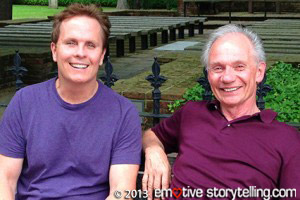
Dr. Gerard Gibbons & Dr. Perry Bosmajian
We are delighted you are here.
You have arrived at the intersection of health information and persuasion where the science of health behavior change moves beyond facts, graphs, pages of text, readiness models and other forms of information overload. The story of healthcare providers and patients alike has been one of frustration, where encouragement, lectures, pamphlets, and increased availability of health data fail to create desired change for prevention or compliance.
We believe that the digital health revolution will not live up to its full potential until the first technology – storytelling – is integrated into the latest technology.
Let us tell you a story.
Fairy Tale: King Cognos and The Wrong Brain © 2013
Once upon a time long ago in a kingdom far away, there were no written words. Just stories — and everything important was taught through them. Generation after generation shared and passed on these stories. They guided people’s lives, values and decisions because they were simple, easy to remember, tugged at their emotions, and the lessons they taught were obvious. It was a healthy and happy time… for everyone young and old had good stories to grow and live by.
One day, the written word came into being. The new King – Cognos I – decreed from his palace window – “Loyal subjects, I hereby decree – use your noggin’ in place of your heart and learn to read.” They obeyed. And over time, sadly, they forgot the stories that had guided them for so long.
Yet, delighted with their progress and because he cared for their well-being, the king filled libraries full of books on how to lead healthy lives. But unfortunately, the people were left alone with this information and expected to decipher meaning on their own.
Many tried to learn medical facts and the consequence of bad habits, but it didn’t make much difference. Stuff just didn’t stick like it used to. As a result, plagues of indulgence – obesity, smoking, drinking colas, and worse – overcame the land.
The wise healers said, “Surely Sire they’ll listen to us!” With that, they boldly set forth to print, publish and preach the same facts over and over, insisting that people get it! But they too failed. Wearing white robes and telling people what they needed, no matter how unrelenting, wasn’t the answer. Even their Royal Readiness for Change Models fell like a brick.
The King in desperation issued an edict to use the new Kingdom Wide Web. And, people flocked online to consume the new form of written word. They searched for information to improve their lives. Oh they found it! Lots of it!! But screens were wordy – and poorly designed. They soon clicked off because it all wasn’t very interesting and gave them a headache. People still did not follow instructions — and would not break their unhealthy patterns. They had become information-rich, yet wisdom-poor, and getting more unhealthy every day. “Alas!” said the King, “what shall become of us?” The sun was setting fast on these once proud people.
“Ah ha!” said the temple of health scholars. We’ve got what they need to get healthy!” The King’s eyes twinkled. Convinced, he spent vast sums from his treasury on better charts, electronic health records, personalized medical information, super infographic dashboards, self-monitors that blinked, gadgets that dinged and apps that zinged !! But these too proved ineffective as cries were heard across the land. “Graphs?! We don’t need no stinking graphs!” — “I’ve got a blue button, what color is yours?” — “Hey, I bet my doctor’s data is bigger than your doctor’s data!” — “Is there an app for measuring my boredom?… cuz I’m dying here!”
Perhaps cognitive stuff worked for the village of Geek and the family of King Cognos, but that was only 10 percent. As for the rest, well they were so overloaded with info and options, and so overwhelmed with how complex things had become, they simply gave up!
Resigned to fate, they slumped back on their couch, grabbed a pizza and switched to watching Kingdom Idol. As they shared a smoke, they concluded that healthy and happy people must only live in fantasy shows, reality TV and movies.
Ah, but little did they know that a wizard was about appear in the kingdom!
The End.
As you can see, our fairy tale has a purpose. Think about how information and efforts to persuade have been successfully transmitted from person to person from the beginning of time. Now consider how long the written word has been available to the average person – only 400 years. Persuasion and teaching have always been accomplished through the use of story and in relationships, whether in the form of a fairy tale, parable or watching the success of a neighbor or mentor. We are wired to pay attention, to persuade and to learn lessons and values in the context of community, most often through stories. We remember information presented in narrative much more effectively than we do information presented as a set of facts.
It’s only been in the last few hundred years that we are expected to learn alone, with a piece of paper or book as our teacher. Changing the presentation from paper to computer or smart phone screen has, in actuality, changed very little – it’s still solitary learning.
Join us as we rediscover of the ancient wisdom of storytelling and combine it with advances in neuroscience, virtual agents, and digital media. The use of narrative to influence health behavior change is being rediscovered, and research has increasingly supported this strategy. Today, these seminal forces and technologies are combining to drive user engagement, adherence and behavior change in healthcare, marketing, education and business.
Welcome to Emotive Storytelling, the Heart and Science of Persuasion.
Gerard & Perry





